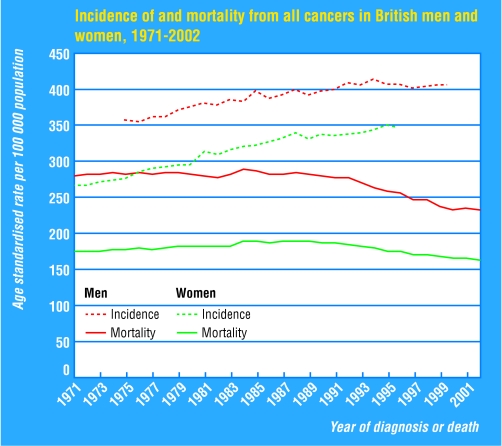More people than ever in Britain are surviving cancer thanks largely to changes in lifestyle, screening services, earlier diagnoses, and prompt treatments, the latest figures have shown. Death rates have been falling while the incidence has been increasing.
Figures from Cancer Research UK show that the death rate for people dying from cancer in the United Kingdom fell by 12% between 1972 and 2002, although the rate of decrease in men is three times the rate in women (18% v 6%).
Improvements in mortality have been seen in the common cancers, such as breast, lung, and bowel cancer, as well as in the less common cancers, such as cancer of the stomach, bladder, and testis and in lymphomas and leukaemia.
The biggest fall in deaths was for stomach cancer. Since 1972 there has been a fall of 65% in the death rate both in men and in women from this type of cancer, which largely reflects falls in incidence. Deaths from bowel cancer also fell significantly, with a drop in death rates of 27% in men and 43% in women, mainly because of better detection and treatment of the disease.
In the same period, mortality from breast cancer in women has fallen by 20% and mortality from testicular cancer has fallen by 37%.
However, the figures for lung cancer again show an unequal split between the sexes. Whereas the death rate in men has fallen by 47% over the period studied, among women, the death rate from lung cancer has risen by 55%, reflecting the fact that since the 1950s many men have given up smoking while more women have taken up the habit.
Professor Peter Selby, director of the Cancer Research UK Unit at St James's Hospital, Leeds, said that with more research into new treatments and screening programmes survival from cancer could increase from the 40% figure as it stands now to 50%. The scientific knowledge base for cancer is so “breathtaking” that it provides “an amazing opportunity to develop treatments for the future,” he said.
Figure 1.
Professor Michel Coleman, professor of epidemiology and vital statistics, London School of Hygiene and Tropical Medicine, said: “The rate from cancer deaths may be falling, but the number of people being diagnosed with cancer is increasing, which indicates that we need more strategies to prevent cancer. The funding of research needs to continue and accelerate so that more people survive the disease in the next generation.”



